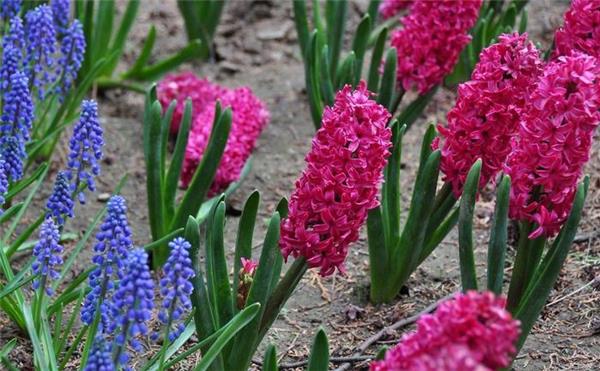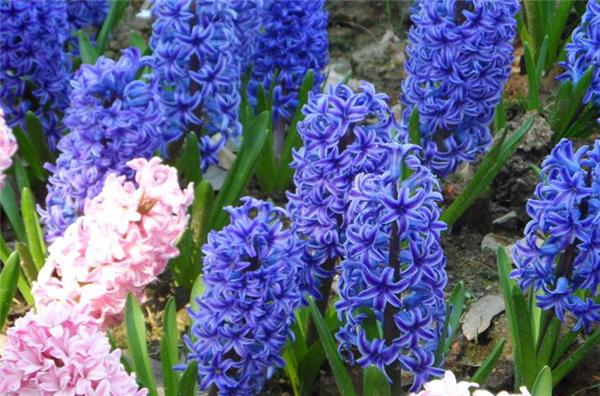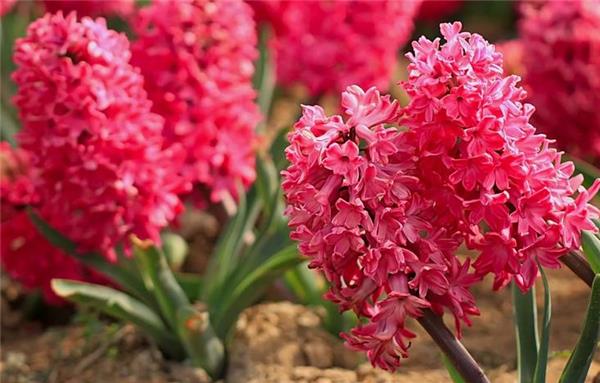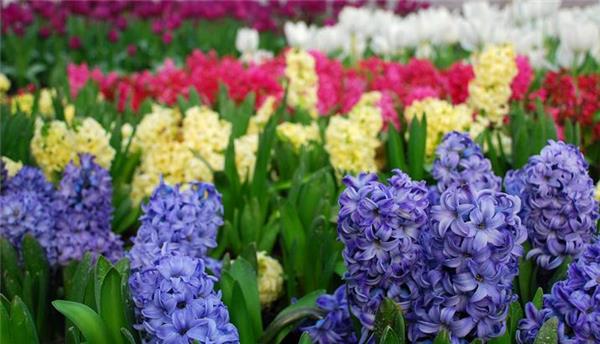Is the smell of hyacinth poisonous?
Hyacinth flower is rich in color, there are red, blue, white and other colors, its flower language is: sad love, everlasting remembrance and so on. Loved by many people, but some people who love her are deterred by the idea that hyacinth is poisonous. Is the smell of hyacinth poisonous?

Is the smell of hyacinth poisonous?
Nature is really a strange master. When it gives beauty to the world, it also brings thorns, poison, aggression and harm to the world. Hyacinth is such a poisonous spirit in the United States. People may not believe that hyacinth is poisonous. It is a famous foreign love flower that conquered the world with beauty and also conquered love. However, hyacinth bulbs are indeed only poisonous, and serious cases can lead to paralysis or even death.
Hyacinth has a strong fragrance as we all know, and many friends with nose allergies can't even stand the smell when the hyacinth is in full bloom. However, its fragrance is safe, but it only contains some aromatic ketones, which can be excluded from the body through human metabolism and has no negative effect on the human body, but I would like to remind you not to put a large number of hyacinths on the dinner table for a long time. It is best not to put it indoors for a long time, so as not to cause unnecessary harm to the body.
The flower scent of hyacinth will not cause harm to the human body, but if you have allergic skin, there is no guarantee. As a famous foreign love flower, hyacinth in different colors has different love meanings, and what attracts people's attention most are purple hyacinth and blue hyacinth. Although these two colors are not as stunning as peonies when they are in bloom, they are also able to attract people's attention, and the faint and sad words of flowers also increase people's pity for hyacinth.
Hyacinth has been introduced into indoor planting as early as a few decades ago, and it is now able to carry out simple water culture after a long period of cultivation. Hyacinths do not have high requirements for soil and environmental temperature, if they are raised indoors, the temperature is fine as long as they are not too low or too high, while outdoors, as long as you pay attention to the basic cold prevention and do not let frost and snow directly harm hyacinth, it is not a delicate plant, but we also need to take good care of it.

The fragrance of hyacinth and primroses will make some people allergic. Now, there are many kinds of flowers and trees on the market, and a large number of southern plants and foreign introduced varieties have sprung up. These flowers and trees are basically harmless. If you are not familiar with some flowers and trees and have doubts, as long as you pay attention to the following points, you can rest easy.
First, prevent children from accidentally eating or direct contact with plant juice.
The living room is always ventilated.
Third, try not to put too many flowers and trees in the bedroom.

Selection and cultivation of hyacinth
Selection and purchase
In the selection and purchase of seed heads, we should pay attention to the selection of bright skin color, strong texture, no disease spots and insect population is good, usually from the color of the seed coat can basically judge what color of flowers it is. For example, if the skin is purplish red, it will have purplish red flowers, and if it is white, it will have white flowers, but some hybrid varieties will have a more complex color, and sometimes they will not be able to distinguish clearly, so they need to ask the operator to buy. When the seed head is bought back, in order to make it break the dormancy period, it should be refrigerated in the bottom box of the refrigerator for about a month so that it can blossom smoothly in the future. But when you take it out of the refrigerator, it is best to put it in a cool place for seven or eight days before sowing.
Cultivation
Many people keep hyacinths in a special glass bottle like a gourd. The flowers of hyacinths can be seen above, and a bunch of stout white roots can be seen below. This kind of flower and root luxuriant scene, with the exception of Cymbidium, its hyacinth flowers are rare. Hyacinth is also called foreign daffodil or colorful daffodil. Hyacinth is more resistant to cold, but afraid of heat. Hyacinth likes cool, moist air and sunny environment. Hyacinth should grow in sandy loam with good drainage and poor growth in heavy clayey soil.
After flowering, if the seed head is well preserved, there is hope that the hyacinth will blossom again in the next year, but because the head has degenerated, even if it is possible to survive, the plant will become short and the scape will tend to shrink, so it can not be retained. It is appropriate to buy a new seed head for cultivation the following year.
You can put the seed head in a wide-mouthed glass bottle in December and add a little charcoal to help with disinfection and antisepsis. The seed head can only be dipped to the bottom of the ball. Then put it in a dark place and cover the bottle with a black cloth. After more than 20 days, the root sprouts out in total darkness, and then it can be exposed to the sun outside. At first, it shines for one or two hours a day, and then gradually increases to seven or eight hours. If the weather does not change much, it may blossom during the Spring Festival.

There are also many families who keep hyacinth in a special gourd-like glass bottle, whose flowers can be seen in the upper section and a stout bunch of white roots in the lower section. This kind of flower and root luxuriant scene, with the exception of Cymbidium, other flowers and plants are difficult to see. It needs to be watered continuously during the growing period. if you stay in the soil, the stems of the flowers should be cut off after flowering, so that the leaves will wither naturally, and topdressing is needed every year. However, some varieties will have fewer and fewer flowers after a few years of planting. If you want to store them after flowering, you need to pull them out. After the leaves are naturally dry, cut off the leaves. It is best to put them in a breathable bag with sawdust and keep them in a dry, ventilated and cool place.
Hyacinth likes cool, moist air and sunny environment. It is more resistant to low cold, but afraid of heat. It is suitable to grow in sandy loam with good drainage and poor growth in heavy clayey soil. Hyacinth bulbs grow to 19 cm before they can blossom. Flowering occurs from March to April every year.
Hyacinth cultivation should first select strong and full bulbs, dry in the shade beforehand, put them in a tile basin in December, mix 1 part of coarse sand, broken pond mud and 1 part of rotten rice bran into nutritious soil, bury the bulb in the soil, cover the bulb with 2m of soil, put it in a place where the sun is sufficient, do not water too much at the beginning, and apply phosphorus and potassium fertilizer once the leaves are exposed to the soil. After flowering, cut off the flower stem and apply fertilizer again. Dormancy from July to August, when the bulbs will not grow up, should be dug up in time in June-July, placed in a cool place, not in the sun, until the Mid-Autumn Festival or to December pot planting.
It can also be hydroponized like daffodils. Water to raise hyacinth, you can put the ball in a wide-mouthed glass bottle in December and add a little charcoal to help with antisepsis and disinfection. The seed ball can be soaked only to the bottom of the ball, then it is placed in a dark place and the bottle is covered with black cloth, so that after germinating in an all-black environment for more than 20 days, it is then put outdoors to be exposed to the sun. At first, it shines for 2 hours a day, and then gradually increases to 8 hours. Most of them can blossom during the Spring Festival when the weather is good. Hyacinth after flowering, if the bulb is well preserved, it can still bloom in the next year, but the flower will be short and the scape will atrophy, which is mainly due to the degeneration of the bulb. Therefore, hyacinth cultivation is better to buy new bulbs after planting for one year.
After more than 20 days, the root sprouts out in total darkness, and then it can be exposed to the sun outside. At first, it shines for one or two hours a day, and then gradually increases to seven or eight hours. If the weather does not change much, it may blossom during the Spring Festival.

There are also many families who keep hyacinth in a special gourd-like glass bottle, whose flowers can be seen in the upper section and a stout bunch of white roots in the lower section. This kind of flower and root luxuriant scene, with the exception of Cymbidium, other flowers and plants are difficult to see. It needs to be watered continuously during the growing period. if you stay in the soil, the stems of the flowers should be cut off after flowering, so that the leaves will wither naturally, and topdressing is needed every year. However, some varieties will have fewer and fewer flowers after a few years of planting. If you want to store them after flowering, you need to pull them out. After the leaves are naturally dry, cut off the leaves. It is best to put them in a breathable bag with sawdust and keep them in a dry, ventilated and cool place.
Hyacinth likes cool, moist air and sunny environment. It is more resistant to low cold, but afraid of heat. It is suitable to grow in sandy loam with good drainage and poor growth in heavy clayey soil. Hyacinth bulbs grow to 19 cm before they can blossom. Flowering occurs from March to April every year.
Hyacinth cultivation should first select strong and full bulbs, dry in the shade beforehand, put them in a tile basin in December, mix 1 part of coarse sand, broken pond mud and 1 part of rotten rice bran into nutritious soil, bury the bulb in the soil, cover the bulb with 2m of soil, put it in a place where the sun is sufficient, do not water too much at the beginning, and apply phosphorus and potassium fertilizer once the leaves are exposed to the soil. After flowering, cut off the flower stem and apply fertilizer again. Dormancy from July to August, when the bulbs will not grow up, should be dug up in time in June-July, placed in a cool place, not in the sun, until the Mid-Autumn Festival or to December pot planting.
It can also be hydroponized like daffodils. Water to raise hyacinth, you can put the ball in a wide-mouthed glass bottle in December and add a little charcoal to help with antisepsis and disinfection. The seed ball can be soaked only to the bottom of the ball, then it is placed in a dark place and the bottle is covered with black cloth, so that after germinating in an all-black environment for more than 20 days, it is then put outdoors to be exposed to the sun. At first, it shines for 2 hours a day, and then gradually increases to 8 hours. Most of them can blossom during the Spring Festival when the weather is good. Hyacinth after flowering, if the bulb is well preserved, it can still bloom in the next year, but the flower will be short and the scape will atrophy, which is mainly due to the degeneration of the bulb. Therefore, hyacinth cultivation is better to buy new bulbs after planting for one year.
Related
- Wuhan Hospital Iron Tree Blooming Result Was Instantly Frightened by the Gardener Master
- Which variety of camellia is the most fragrant and best? Which one do you like best?
- What is the small blue coat, the breeding methods and matters needing attention of the succulent plant
- Dormancy time and maintenance management of succulent plants during dormancy
- Minas succulent how to raise, Minas succulent plant pictures
- What are the varieties of winter succulent plants
- How to raise succulent plants in twelve rolls? let's take a look at some experience of breeding twelve rolls.
- Attention should be paid to water control for succulent plants during dormant period (winter and summer)
- Watering experience of twelve rolls of succulent plants
- Techniques for fertilizing succulent plants. An article will let you know how to fertilize succulent plants.



